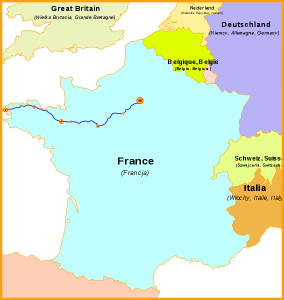Kedge: PBP 2015
 Paris–Brest–Paris (PBP) (1200km / 745.65 miles) is held every 4 years. The goal is to complete the distance within 90 hours, but with no competition. The event was originally a bicycle race from Paris to Brest and back to Paris. It is the oldest bicycling event still regularly run. The first Paris-Brest was held in 1891.
Paris–Brest–Paris (PBP) (1200km / 745.65 miles) is held every 4 years. The goal is to complete the distance within 90 hours, but with no competition. The event was originally a bicycle race from Paris to Brest and back to Paris. It is the oldest bicycling event still regularly run. The first Paris-Brest was held in 1891.
Paris-Brest-Paris will take place in August (21-25) this year, which means the next one is scheduled for 2015; the year the MexicanSongBird turns 60.
Holy Crap! Who’s In??
In 1931 amateur cyclists were separated from professionals. There were two independent long distance bicycle tours. One is the Brevet (also called randonnée), in which cyclists ride individually. The other is an audax where cyclists ride in a group, held every five years. So in 1931 there were three independent cyclings events, sharing the same route.
The audax is organised by the Union des Audax Françaises, while the Brevet is organised by the Audax Club Parisien. Visit Wikipedia for more information.
Registration, Qualifications etc: http://www.paris-brest-paris.org/
What is a Randonnée??
Randonneuring is a type of organized long distance bicycle riding, with rides typically covering between 100 and 1,200 kilometres (60–750 miles). A participant is known as a randonneur, and an event is a randonnée. The term brevet may be used interchangeably with randonnée, although strictly speaking, a brevet is one specific type of event.
Randonneuring is not a competitive sport. It is a test of endurance, self-sufficiency and bicycle touring skills. All riders who complete the task are congratulated, and no prizes are given to those with the fastest times.
Riders are expected to carry clothing for inclement weather, spare parts and tools. Rides in excess of 300 kilometers frequently involve night riding and require lights, spare bulbs and reflective gear.
The term brevet may also refer to the certificate of completion given to riders who complete a brevet.
To ensure that the correct route is followed and no short cuts are taken, the rider must pass through a series of locations known as “controls”. The rider carries a “brevet card”, onto which information is added at each control, and this card is presented to the organizers at the end of the ride as proof that the route was followed. There are two types of controls. The first is a “manned control”, usually at a village hall or cafe, at which someone waits to stamp the riders cards as they pass through. On longer rides a manned control may be a shop, where the rider must obtain a till receipt showing the date and time. The second type of control is an “information control”, more commonly called an “info control”, where the rider must answer a question. For example, if the card asks, “From the signpost at the T-Junction, how far is it to Oadby?”, the rider must find the signpost and write the answer on the brevet card.
Write a comment
You need to login to post comments!
